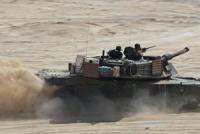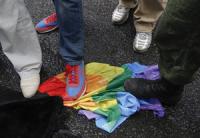-
We are watching you: U.K. CCTV strategy
There are over six million CCTV cameras in the United Kingdom – one CCTV camera for every ten citizens. This number does not include body-cam footage, unmanned aerial vehicles, or the automatic number plate recognition system. Britain has 20 percent of the world’s cameras despite being home to less than one percent of its population. In 2015, turnover for the video and CCTV surveillance sector topped £2.12 billion in the United Kingdom. The government has just released a draft national surveillance camera strategy for England and Wales.
-
-
Shark antibodies for chemical, biological threat detection, treatment
New research shows that shark antibodies offer new alternatives to chemical and biological threat detection and treatment tools. In an era of Department of Defense belt-tightening, the goal is to find more innovative, cost-effective approaches to protecting our warfighters.
-
-
Lessons learned in U.S.-Canada cross-border experiment
DHS S&T First Responders Group (FRG) and Canadian partners held the CAUSE IV experiment on the Michigan-Ontario border. The two territories are connected by the Blue Water Bridge spanning the St. Clair River, which is the second-busiest transit point between the United States and Canada. The goal of the CAUSE experiment series is to stage emergency scenarios to prepare first responders and communities on both sides of the U.S./Canada border for a potential natural or manmade disaster.
-
-
ISIL uses toxic chemicals in its defense of Mosul
In the run up to the U.S.-led coalition campaign to liberate Mosul, U.S. officials warned that ISIS would likely use chemical weapons to slow down the progress of coalition forces and terrorize the residents. Last Thursday ISIS took the first step in its chemical strategy by setting ablaze the Mishraq Chemical plant and sulphur mine, located thirty km south of Mosul. The toxic cloud includes lethal sulphur dioxide and hydrogen sulphide. When combined with residue from burning oil wells, it is deadly for people caught in the open or without gas masks. Military experts say health effects from the toxic fumes from oil and sulphur will likely subside in about eighteen months, but the toxic clouds could harm much of the plant and animal life in the area and make it difficult for local farmers to return to their fields until then.
-
-
Assad regime used chemical weapons: UN
The White House on Saturday sharply condemned the use of chemical weapons by the government of Bashar al-Assad, after an international inquiry found that Syrian government forces used toxic gas in spring 2015 in attacks on two rebel-held towns. The fourth report from the 13-month-long inquiry by the UN and the Organization for the Prohibition of Chemical Weapons (OPCW), the UN chemical weapons watchdog, blamed Syrian government forces for a toxic gas attack in Qmenas in Idlib governorate on 16 March 2015.
-
-
Suspension of U.S.-Russia plutonium disposal agreement a setback: Expert
Earlier this week the lower house of the Russian parliament approved President Vladimir Putin’s decree on suspending the U.S.-Russian Plutonium Management and Disposition Agreement (PMDA), which requires each nation to dispose of thirty-four metric tons of plutonium from its dismantled nuclear weapons and military stockpiles. Russia has claimed that the United States is violating the agreement by changing its disposition method from irradiating the plutonium as mixed-oxide (MOX) fuel for commercial nuclear reactors to a process called dilute and dispose, but a nuclear expert says that the United States has not violated the terms of the PMDA by proposing that it change its plutonium disposition approach.
-
-
More powers, tighter monitoring: Germany reforms its intelligence service
The Bundestag has passed a comprehensive reform of the BND, Germany’s main intelligence service. The legislation strengthens government monitoring of intelligence powers, and allows the BND to carry out certain types of surveillance activities. The reform is a response to two recent developments: the 2013 Snowden revelations that the BND had spied on German citizens on behalf of the NSA, and the growing concerns about terrorism in Europe. The new legislation thus gives the BND more powers – but subjects it to tighter judiciary monitoring.
-
-
U.S. military challenged by other nations’ improved abilities to deny access to territory

A U.S. military strategy based primarily on an ability to deploy troops anywhere it feels necessary will face heightened costs and risks in critical regions by 2025, owing to other nations’ improved abilities to deny the U.S. access, according to a new study. Anti-access and area denial are the two biggest threats to the U.S. ability to project its military forces.
-
-
Special forces should be at the heart of Britain’s military planning
What sort of military does the United Kingdom need to deal with a rapidly changing set of potential threats? As Western countries increasingly move away from the conventional foe — one that is easily identified, armed in a similar way and which, most critically, thinks in a similar way, and therefore in a conventional and predictable manner – it’s time to reappraise the sort of armed forces required for the future. It is no longer the size of your arsenal of firepower but how well it is employed that matters. Organizations such as Islamic State understand that well: their actions are carefully targeted to achieve maximum effect with limited resources. With technology on the Western side, the best counter to this present – and likely future – threat, will be to adopt in turn Voltaire’s maxim and concentrate increasingly on special, and specialized, forces.
-
-
170,000 hate crimes go unreported in the U.K. each year

Hate crimes are massively under reported, making it all the more difficult for police and other authorities to make an impact on the issue. Now, researchers have devised techniques that could result in much more accurate estimates.
-
-
Half of American adults are in a little regulated police face recognition database
Half of American adults — more than 117 million people — are in a law enforcement face recognition network, according to a report. Of the fifty-two government agencies that acknowledged using face recognition, only one obtained legislative approval for its use and only one agency provided evidence that it audited officers’ face recognition searches for misuse. Not one agency required warrants, and many agencies did not even require an officer to suspect someone of committing a crime before using face recognition to identify her.
-
-
Fire and explosion investigation guideline approved for OSAC Registry
The Organization of Scientific Area Committees (OSAC) for Forensic Science has approved the National Fire Protection Association Guide for Fire and Explosion Investigations for inclusion on the OSAC Registry, which serves as a trusted repository of high-quality, science-based standards and guidelines for forensic practice. This is the first guideline to be included on the OSAC Registry, where it joins the first standard, which was listed earlier this year.
-
-
Thousands of people didn’t evacuate before Hurricane Matthew. Why not?
As Hurricane Matthew approached the Atlantic coast earlier this month, many residents followed orders to evaqcuate, but others stayed in place. Hurricane Matthew illustrates the challenges of managing disaster evacuations effectively. By understanding who is likely to obey or ignore evacuation orders, authorities can use data to reduce the number of false alarms and concentrate limited resources on groups who are most likely to choose to shelter in place. It is critical to grapple with these issues so we can do a better job responding to the next storm, which likely won’t be ten years away.
-
-
“Drop, Cover, and Hold On”: Worldwide ShakeOut drill to be held 20 October
USGS scientists recently determined that nearly half of Americans are exposed to potentially damaging earthquakes based on where they work and live. Still others will be at risk when traveling. USGS asks Americans to be prepared to join millions of people from around the world participating in Great ShakeOut Earthquake Drills worldwide on 20 October. During the drill, participants practice “Drop, Cover, and Hold On.” This is the recommended safety action to take during an earthquake.
-
-
3 Kansas men arrested for plotting massive attack on a complex housing Somali refugees
The Garden City, Kansas police on Friday arrested three members of a far-right militia group for plotting to bomb an apartment complex in Garden City, in which about 120 Somali refugees live. The complex also houses a mosque. Supporters of far-right nationalist ideology – sometime referred to as “alt-right” – have been using an apocalyptic language, which has been adopted by Donald Trump, describing the refugee program as an “invasion” of the country which amounts to “national suicide” for the United States.
-
More headlines
The long view
Why Was Pacific Northwest Home to So Many Serial Killers?
Ted Bundy, Gary Ridgway, George Russell, Israel Keyes, and Robert Lee Yates were serial killers who grew up in the Pacific Northwest in the shadow of smelters which spewed plumes of lead, arsenic, and cadmium into the air. As a young man, Charles Manson spent ten years at a nearby prison, where lead has seeped into the soil. The idea of a correlation between early exposure to lead and higher crime rates is not new. Fraser doesn’t explicitly support the lead-crime hypothesis, but in a nimble, haunting narrative, she argues that the connections between an unfettered pollution and violent crime warrant scrutiny.
Bookshelf: Smartphones Shape War in Hyperconnected World
The smartphone is helping to shape the conduct and representation of contemporary war. A new book argues that as an operative device, the smartphone is now “being used as a central weapon of war.”
